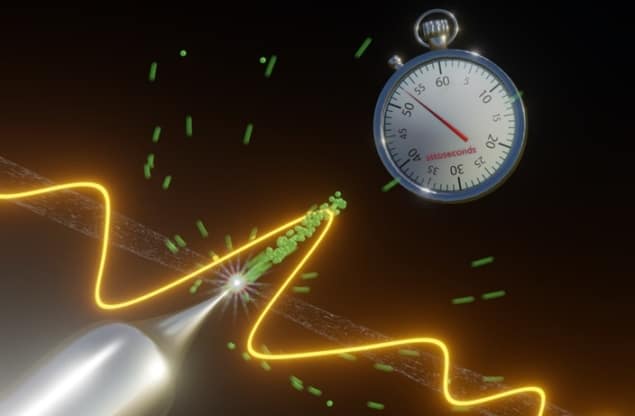
The shortest electron pulses ever made in the lab have been claimed by researchers in Germany. By firing ultrashort laser pulses at a tungsten nanotip, the team created electron pulses just 53 as (53×10-18 s) long and then characterized the pulses using a new technique.
When a short, intense laser pulse is fired at a material it can cause the emission of an extremely short pulse of electrons. These electrons are then driven back into the material before re-emerging – a process that can provide important information about the material’s properties. The challenge in doing such experiments is knowing how long the electron pulses are and characterizing the electrons that are emitted.
Now, Eleftherios Goulielmakis and colleagues at the University of Rostock have developed a new technique to create and study ultrashort electron pulses. In their experiment, an intense laser pulse is fired at tungsten nanotip that is just 70 nm in diameter at its apex. This causes the emission of a pulse of electrons from the tip. Crucially, the laser pulse is so short that it comprises less than one cycle of the light (about 2 fs). This ensures that the emitted electron pulse is not buffeted around by an oscillating electric field, but instead the electric field gives the electrons a precisely controlled kick in the right direction.
Time-varying shift
After being ejected, the electrons are immediately drawn back to the nanotip, and then backscatter off its surface. This imprints the electron pulse with information about the structure and dynamics of the nanotip. In the next the step of the experiment, the re-emerging electrons are hit with a second laser pulse that is much weaker than the first. This introduces a time-varying shift, or “chirp” in the energy of the pulse, which allows the team to better characterize the pulse using an electron spectrometer.
At the highest peak intensity used for the driving laser pulse, about 1000 electrons were released from the nanotip. The team also found that the electron pulses endured for just 53 as, making them the shortest electron pulses to be made and characterized in the lab. The experiment also marks the first time that the time-varying profile of an attosecond electron pulse has been determined accurately.

New laser technique could give electron microscopes a boost
The new technique could have exciting implications for science – particularly in electron microscopy. With the ability to probe matter at both picometre spatial scales and attosecond timescales, the technique could open a new window into the nanoworld.
Beyond its research applications, Goulielmakis and colleagues hope their discoveries could pave the way for ultrafast microcircuits in which electron pulses travel directly through a vacuum rather than in conducting wires. This could lead to new types of electronic devices that operate thousands of times faster than conventional electronics.
The research is described in Nature.
- SEO Powered Content & PR Distribution. Get Amplified Today.
- Platoblockchain. Web3 Metaverse Intelligence. Knowledge Amplified. Access Here.
- Source: https://physicsworld.com/a/attosecond-electron-pulses-are-claimed-as-shortest-ever/
- 70
- a
- ability
- About
- accurately
- allows
- and
- Apex
- applications
- around
- back
- before
- being
- Better
- Bunch
- Cause
- causes
- challenge
- characterize
- characterized
- claimed
- colleagues
- conducting
- controlled
- conventional
- could
- create
- created
- crucially
- cycle
- described
- determined
- developed
- Devices
- direction
- directly
- doing
- driven
- driving
- dynamics
- Electric
- Electronic
- Electronics
- electrons
- emission
- energy
- ensures
- EVER
- exciting
- experiment
- extremely
- faster
- field
- firing
- First
- first time
- found
- from
- FS
- Germany
- Give
- gives
- Green
- highest
- Hit
- hope
- How
- HTTPS
- image
- immediately
- implications
- important
- in
- information
- instead
- Introduces
- issue
- IT
- kick
- Knowing
- lab
- laser
- lead
- light
- Long
- made
- Making
- material
- Matter
- max-width
- Microscopy
- Nature
- New
- next
- ONE
- open
- operate
- particularly
- Peak
- plato
- Plato Data Intelligence
- PlatoData
- precisely
- probe
- process
- Profile
- properties
- provide
- pulse
- released
- research
- researchers
- result
- scales
- Science
- Second
- shift
- Short
- So
- Spatial
- Step
- structure
- Study
- such
- Surface
- team
- The
- their
- thousands
- Through
- thumbnail
- time
- times
- tip
- to
- travel
- true
- types
- university
- Vacuum
- which
- works
- zephyrnet













